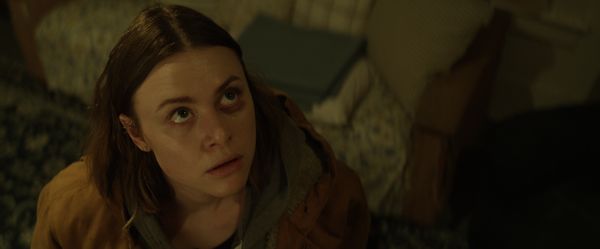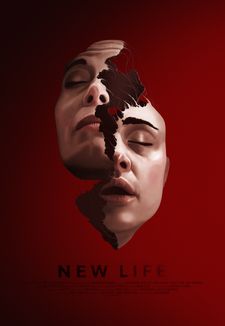 |
| Hayley Erin in New Life |
Recently screened at Fantasia and now on its way to Frightfest, John Rosman’s New Life follows a woman called Jessica (Hayley Erin[/film] who is trying to make her way across the US as she is hunted, at the bequest of a mysterious organisation, by a woman named Elsa (Sonya Walger) – and for the first 40 minutes or so, that’s all we know. It’s a film which packs in some major twists and turns. Whilst i strove to keep my review spoiler-free, there are some minor spoilers in this interview, so if you want to see the film completely fresh, you may prefer to wait and read this afterwards. If you do choose to read on, don’t worry too much – the film will still have some surprises in store for you.
One of those spoilers is that Elsa is afflicted by ALS (more commonly known in the UK as motor neurone disease) and, from the outset, knows that she doesn’t have long to live. The film uses this to explore more complex themes around mortality and it is intensely bleak in places, but when I met John, I explained to him that that, for me (as somebody with a different type of serous illness), was balanced by excitement at seeing a character like this portrayed so realistically onscreen. Elsa may be dying but she still values her life and she’s fully engaged with the world on every level. John is pleased by the vote of confidence, and explains that this is an aspect of the film which he worked hard to get right.
 |
| John Rosman and friend Photo: Noah Dye |
“The personal aspect to this film was that in my career in journalism I went with a team and we interviewed a woman who was my age, and she had ALS, the advanced version. She was typing by eye on her screen, and to see that was dark, and but she wrote a memoir, and I read the memoir, and in it I found a lot of radical optimism, which was so surprising. I mean, just because the assumption that I had was how horrific and unfair something like this is, which it is, but to read that memoir and see that and see someone of my own age, going through something so much bigger than anything I had ever gone through, it really stayed with me.
“When it started becoming part of the film, I started doing more research and talking to more people in the ALS community, and specifically a journalist, Dagmar Munn, who writes a column for ALS Today called Living Well With ALS. There are a lot of people I talked with who had this optimism, and were experiencing something really deep and big about the human condition that I don't really have that insight into, but coming back with something really positive that I found so inspiring. I wanted, and I needed to kind of put it in my character afterwards.
Dagmar and another person with ALS read the script at various stages and kept him honest, he says. Despite never having faced a crisis on that scale in his own life, he recognises that most people have to face up to disability at some stage in life, and everyone ultimately has to deal with mortality. I suggest that society’s experience of the Covid pandemic must have informed the film – and audience responses to it – as well.
“Yeah, being locked in our homes for a couple of years and, as a society, having to make choices to benefit all of us that sometimes go against our personal desires. It really did create a lot of weird insights into the world we live in and the world we're going to continue living in for the next foreseeable future, which I think is an interesting backdrop when we're discussing mortality and when we're discussing making choices in uncertain times.”
That would seem to be reflected a bit in the way that the film is shot, because we spend a lot of time in small spaces or hemmed in by shadows before the landscape finally opens up at the end.
“The movie has these two narratives,” he says. “There's Jess’ narrative and there’s Elsa’s narrative. Jess’ narrative is really about freedom and wanting to escape her past and find something new for herself. The last scene takes place under a giant mountain. It’s a stirring image to see a mountain range, and I think that it really does dovetail nicely into what she wants, this visual of what she's searching for.”
Is it also about shifting viewers’ perspectives?
“Yeah. A lot of the movie takes place in rooms, and then in darkness and shadow, but the mountainscape is in broad daylight. There's no shadow, there's nothing hiding. The actual camera moves, there's nothing crazy happening. It's just a single shot of one person talking to another. It’s all in the light and you can’t hide anything.”
At the start of the film, we're just watching one woman try to run away and escape from somewhere and we don't know anything about her. How did he approach building up that part of the film in such a way that the audience would be rooting for her?
He smiles. “The fun thing, she's covered in blood, and you very quickly forget that, right? You just do, but in order for that to work you need to root for her and the way you root for characters, I think, it's the little choices. It’s how she acts when people are being nice to her. In the bathroom, in an earlier draft, I had her taking some painkillers, and it's like, well, I think it's actually more interesting if she sees the drugs and doesn't take more than she needs then. She takes deodorant or like, in the car, she doesn't take money, she takes crackers.
“These are the choices of the writing process. All her actions are justifiable and none of it is like she's doing it out of self interest, or whatever reason. I think it makes her a more compelling character.”.
There are these two different characters and we don't know how they're connected early on. And then there are also flashbacks. How did he get the balance right between all those things and keep people involved?
“That was the big challenge,” he says. “And that lay all the way through the later edits of the film because it really does open up like a completely different type of movie. I think that was important and fun to play with. And I liked that. But you know, if you're making a horror movie, you want to keep a horror audience engaged, so how much time do you spend there? How do you make sure it’s still moving and not too meandering and that you’re giving the right information when you should?
 |
| New Life poster |
“You want to give enough information so it doesn’t feel like a complete punch on the side of the face, enough breadcrumbs so you can feel like you're getting a step ahead, but never in front of the narrative. It's tricky to decide. I was watching one of the screenings and to the front of me were two 20-year-olds, and this one 20-year-old was looking so bored.” He laughs. “It’s fine. I totally get it. But then once it starts ratcheting up, he and his friend kind of leaned in. He'd probably give it a really mixed review, to be honest, but it did engage him long enough to get to the horror part. I love horror movies and I feel like we worked hard to do the horror part right.”
I ask if he always knew that he was going to have access to Bob Dylan’s Like A Rolling Stone, which Elsa listens to frequently and which is narratively spot on for the film, but a big investment for a small production.
“I think it was it was a real, real miracle to get that song,” he says. “And you know, my music supervisor, I still really don't understand how he did it, but he pulled it off. And then I told him that as long as he lives, he'll never have to buy another drink around me. And he hasn't.
“It's like really iconic. I think it might show who Elsa was before, at work, and she might have to re-identify later. And then yeah, I mean, the themes and the ideas in that song are so cinematic and widescreen that just having it in my movie....” He trails off, still awed that it worked out. “At the end of the day, having Bob Dylan and my first movie – he's been a hero of mine for I don't know how long. So there's a very selfish reason as well. I gave him a title card at the end. I didn’t have to but I wanted to make sure everyone noticed I’ve got Bob Dylan in my movie.”
He’s still a little blindsided by the film’s festival success.
“I was really nervous but the community at Fantasia just loves movies and they're just there to watch films, and the community that Mitch [Davis] helped build really celebrates filmmaking. So to show my movie there was just so awesome. I'm so thrilled and excited. I think there's so many steps in any creative process, whether it's writing, journalism or anything, where there's a lot of negativity or self doubt, or just uncertainty. Getting into Frightfest for that Friday night, screening on an IMAX, I needed to take a big step back and be like, ‘This isn't normal.’ It just has to be enough. If this is all I get out of this film, if everyone hates it, whatever. Showing my film in this moment has to be enough, and I have to really enjoy it and be excited by it. It's so much more than I could have ever imagined. I'm so grateful and excited.
“I just really want to keep on making films. Our executive producer, David Lawson works with these two directors, Justin Benson and Aaron Morehead. They make these great sci-fi films and they're awesome. But what I really admire about their career is that they just do it. They find a way to just keep on putting out more work and and continuing to make films, and that's something that I want for myself here because it's such a cool process. It's really difficult and it really is hard to find a way, but that's the big goal of mine, just to keep on making work.”





















